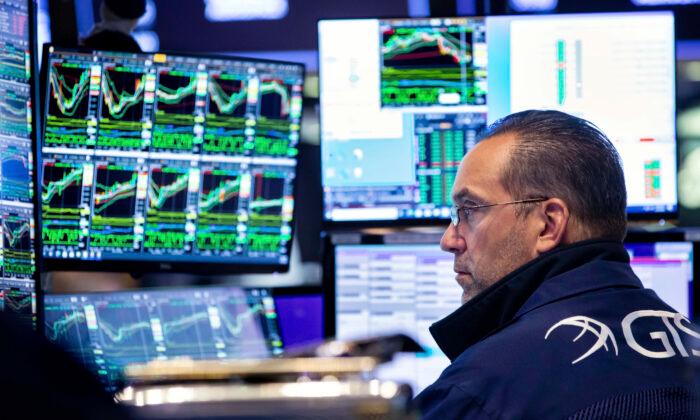NEW YORK—Stocks fell broadly on Wall Street Wednesday, erasing most of their gains for the week, as investors were discouraged to see more evidence of inflation’s impact on businesses and another gloomy outlook on the global economy.
The losses follow several bumpy days for markets, with major indexes often lurching between gains and losses by the hour. The volatility persists as investors try to determine how rising interest rates and inflation will impact the economy.
The S&P 500 index fell 44.91 points, or 1.1 percent, to 4,115.77. The benchmark index managed to hold on to a slight gain for the week. It has notched losses for eight of the last nine weeks.
The Dow Jones Industrial Average fell 269.24 points, or 0.8 percent, to 32,910.90 and the Nasdaq fell 88.96 points, or 0.7 percent, to 12,086.27.
Banks and industrial companies were among the biggest weights on the broader market. Wells Fargo fell 1.8 percent and Union Pacific shed 3.1 percent. Some technology stocks also fell. Intel lost 5.3 percent.
Smaller company stocks fell more than the rest of the market. The Russell 2000 fell 28.56 points, or 1.5 percent, to 1,891.01.
Bond yields rose. The yield on the 10-year Treasury, which banks use to set rates on mortgages and other loans, rose to 3.02 percent from 2.97 percent late Tuesday.
The big concerns on Wall Street remain rising inflation and whether the Federal Reserve’s shift to aggressively raise interest rates will help temper the impact or possibly push the economy into a recession.
“What investors need to realize is it’s going to be a long time until inflation numbers look good,” said Brian Levitt, global market strategist at Invesco. “What they need to focus on is whether it gets better or worse related to expectations.”
Inflation continues to sting businesses. Lawn care products company Scotts Miracle-Gro slumped 8.9 percent after slashing its profit forecast for the year because retailers aren’t replenishing orders as expected. Retailers have been warning that inflation is crimping sales as consumers shift to either spending on services or focusing on necessities rather than purchasing otherwise discretionary items, like electronics.
The impact from inflation has only been worsened by Russia’s invasion of Ukraine, which has put more pressure on energy and food prices since February. U.S. crude oil prices rose 2.3 percent on Wednesday and are up 63 percent for the year, while wheat prices are up 39 percent in 2022. Supply chains have also gotten tighter following a series of lockdowns for Chinese cities fighting COVID-19 cases.
“As long as commodity prices remain elevated, its going to be more difficult to see headline inflation come down,” Levitt said.
Greater inflation pressure from the conflict in Ukraine and lockdowns in China prompted the Organization for Economic Cooperation and Development to cut its forecast for economic growth, following several other international groups, including the World Bank, that expect inflation to have a lingering impact on economies around the world.
Treasury Secretary Janet Yellen, testifying before the Senate Finance Committee on Tuesday, said she expects inflation to remain elevated and bringing that down is a top priority. The Fed is widely expected to raise its key short-term interest rate by half a percentage point at its meeting next week. That would be the second straight increase of double the usual amount, and investors expect a third in July.
The Fed’s goal is to slow economic growth enough to cushion inflation’s impact. Demand for goods had been outpacing supplies and production capacity through most of the post-pandemic recovery. But, investors are concerned that the Fed could go too far too fast in raising rates and nudge the U.S. economy into a recession, especially with economic growth already slowing.
Wall Street is closely watching economic data for signals that could prompt the Fed to potentially ease up on the size of its rate increases. The next big update on inflation arrives Friday, when the U.S. government releases its latest reading on the consumer price index.





